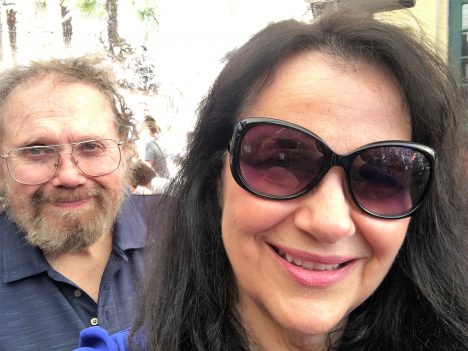Featured Posts

California natives are found of describing the four seasons as fire, mudslides, drought, and earthquake.
That, of course, is more whimsical than real, but California is an extreme state and the weather is no exception. And it does somewhat tie together. A rainy winter, causes the brush to grow thicker which means when the drought rolls around, there is more dried-out wild vegetation to burn. On the other hand, the authorities also warn that a drier winter means the underbrush will be even drier than usual, which means that the fire season will still be bad. There is no winning. When the vegetation burns away it leaves the hillsides bare, which means that when the rains return there will be massive mudslides.
Earthquakes are the outlier in all this. They can happen anytime in the year and they always exacerbate whatever widespread disaster is taking place at the time.
I think there should be another disaster season in California – the whacky-politician season. California left alone is the most beautiful state in the nation. When politicians and political activists get involved, the entire state turns into a giant refried mess.
What brings this to mind is that this is the fire season in California. The hills are burning away and the haze and ash hangs in the sky like a post-apocalyptic preview for the end-times.
Welcome to the Golden State.
As it turns out, the last week of forest fire in Northern California alone has put more pollution in the air than an entire year of automobiles and trucks state-wide. That fire, although huge and expected to burn for weeks to come, is only one of several forest fires in the state so far this year.
And that’s not the worst of it. Pollution from cars and trucks has been studied to death and even exaggerated in order to support expensive and onerous air-control regulations that add to the cost of cars, trucks, and fuel. The pollution from forest fires has not undergone the same level of scrutiny. Each different species of trees that burn put a different mix of particulate matter into the air, a mix whose health effect is little understood.

A secondary effect is how forest fires set back efforts to reduce greenhouse gas emissions, particularly carbon dioxide that is thought to be a major factor in global warming. Living trees soak up carbon dioxide and release oxygen into the air. Burning trees release the carbon dioxide they absorbed over the years back into the air in sudden and massive amounts. No matter where you stand on global warming, California summers do appear to be getting hotter and the climate getting dryer.
But global warming is not the only reason for the increase in massive wild fires and maybe not even the primary one.
Former California Republican Assemblyman Chuck DeVore recalls forest product industry folks telling him in 2005 how difficult and expensive it was to do business in California. Over the ensuing years, the California timber industry shrank to less than half of what it formerly was.
The shortfall in timber was made up by wood imports from other countries. As the forestry industry declined, undergrowth in the forests was no longer being cleared and sick and dying trees no longer being removed. The environmental maintenance once performed by the timber companies was no longer taking place.
One result has been the intensity and frequency of fires has increased. All the burning underbrush and dead trees, which act as kindling, results in a fire that becomes so hot that it sterilizes the soil and makes it difficult for the forest to recover.
Eight months ago, the U.S. Forest Service and Cal Fire issued a joint warning that 129 million trees have died on 8.9 million acres in California because of years of drought and an infestation of bark beetles. The problem is that the Forest Service is spending so much money on fire suppression that there is less available each year for reforestation, removal of dead trees, and watershed management.

Spending more money of forestry – clearing out the undergrowth and taking out dead trees, would do more to reduce pollution than declaring war on refineries that supply the gasoline and diesel fuel we use in our cars and in the trucks that companies use to deliver the goods we need to market.
And it would create jobs. The underbrush and dead trees could be buried in a landfill, where they would decompose and eventually create methane that could at some point be drawn off and used as fuel, or they could be burned in an incinerator with scrubbers that would remove most of the pollution. Neither of those solutions is perfect, but in the real world, perfect is an ideal, not a reality.
It seems like common sense, but this is California, where common sense is not as common as one might think.
Do you have a dissenting opinion or any opinion at all on the subject? Contact me at george@georgeleecunningham.com and let me know. Meanwhile, you can always subscribe and get an email reminder of blog postings. Your name will not be shared and you may cancel at any time.
A place to share some words of beauty, inspiration, and life. It’s the fire season in California and today’s lyrics are all about burning. Burning with desire, burning with lust, burning with passion. The first song, by June Carter, was inspired by Johnny Cash. The two had an affair, while he was still married to another woman and the father of four children. But love conquers all, or is it just lust? The second song by the “Killer,” Jerry Lee Lewis is a song of passion, desire, and full-speed-ahead joy. And the last by Jim Morrison of the Doors, includes both lyrics and a poem that makes you remember just how silly the ’60s were and makes you wish – just a little – that you had never given up on recreational drugs. Click on the name of the piece to get a video or more information.
Love is a burnin’ thing
And it makes a fiery ring
Bound by wild desire
I fell into a ring of fire
I fell into a burnin’ ring of fire
I went down, down, down
And the flames went higher
And it burns, burns, burns
The ring of fire, the ring of fire
– Ring of Fire Singer: June Carter; Songwriters: June Carter & Merle Kilgore
You shake my nerves and you rattle my brain
Too much love drives a man insane
You broke my will, oh what a thrill
Goodness gracious great balls of fire
I learned to love all of Hollywood money
You came along and you moved me honey
I changed my mind, looking fine
Goodness gracious great balls of fire
– Great Balls of Fire Singer: Jerry Lee Lewis; Songwriters: Jack Hammer & Otis Blackwell
The time to hesitate is through,
No time to wallow in the mire,
Try now we can only lose,
And our love become a funeral pyre.
Come on, baby, light my fire,
Come on, baby, light my fire.
Try to set the night on fire. Yeah!
PLUS “Graveyard Poem”
It was the greatest night of my life.
Although I still had not found a wife
I had my friends
Right there beside me.
We were close together.
We tripped the wall and we scaled the graveyard
Ancient shapes were all around us.
The wet dew felt fresh beside the fog.
Two made love in an ancient spot
One chased a rabbit into the dark
A girl got drunk and balled the dead
And I gave empty sermons to my head.
Cemetery, cool and quiet
Hate to leave your sacred lay
Dread the milky coming of the day.
– Light my Fire/Graveyard Poem Singer/Group: Jim Morrison, The Doors; Songwriters: John Densmore, Jim Morrison, Robby Krieger & Ray Manzarek

In the old days, if you screwed up your life, you could always pack up, move on, and start over. But those days are gone.
We live in an age, when every time you ever messed up – from skipping school in seventh grade to exposing yourself on Spring Break – has become part of your permanent record. All those acts, great and small, noble and pathetic, will be following you around for the rest of your life, no matter where you go or what you do.
What brings this to mind is that my wife Carmela has just begun working with women prisoners. To get the job as an unpaid volunteer, she had to go through days of filling out forms about our finances, her work history, any criminal record, and any involvement with illicit drugs whether it resulted in an arrest or not. It was six months before she was deemed worthy of becoming part of the Facility’s Re-entry program, and before she got her pass, she also had to sign a waiver that stated in case she was taken hostage, no deals would be made for her release.
Admittedly, the chances of that are slim – Carmela will not be working with hard-core felons – but the act of signing such acknowledgement emphasizes that what she is doing is serious and includes some personal risk.
She begins this effort even though she has been warned by some smart law enforcement people that she will be wasting her time.
The common cop wisdom is this:
There is little you can do for these people – they are not only lost, they are too lazy or stupid to ever change. That may in fact be true. “Common wisdom” is common wisdom because most of the time it is correct. And cops, unlike most of us, work around low-level criminals every day, so they know first-hand the sort of people with whom Carmela will be dealing.
But there is a self-fulfilling element to all this. If everybody agrees that there is no redemption for the folks in jail – and FBI statistics tend to reinforce that view – then the common wisdom becomes a self-fulfilling prophesy.
If you start out with the attitude that people are going to screw up, then the probability that they will becomes overwhelming.
The problem is that many criminals think that once they’ve served their time, they have paid their debt to society, but that’s not true. Serving your time is one thing. Being forgiven by other people – even people you may have victimized – is different. Criminals don’t win back their reputation by serving time. In fact, their reputation is probably worse than when they were sent away, just from the fact that now they are ex-cons – state-certified bad people.
Try getting a job with that hanging over your head.
The problem is if nobody forgives them, they will never be able to rejoin society and lead an honest and productive life. Carmela is going to be helping women prisoners learn the skills – and hopefully acquire the attitude – to prepare to look for work when they are released. She also hopes to give them a little encouragement that life can get better if they are willing to put in the effort needed to turn their lives around.
If they are unable or unwilling to put in that effort, then there really is no hope for them. And since most of the women she has met in jail are mothers, and a few are pregnant, the tragedy of their lives is passed along from one generation to another.
The challenge for the ex-prisoners is to convince people who have already made up their minds about them to reconsider. They need to acknowledge that they were wrong and ask society to forgive them. Anybody who has ever been through a 12-step program understands how important it is to accept responsibility and be willing to make amends.
Most of the prisoners probably will not, but some of them may – and those are the folks that Carmela hopes to help.
Do you have a dissenting opinion or any opinion at all on the subject? Contact me at george@georgeleecunningham.com and let me know. Meanwhile, you can always subscribe and get an email reminder of blog postings. Your name will not be shared and you may cancel at any time.
A place to share some words of beauty, inspiration, and life. Today’s lyrics are all about being in jail. One of them. Jail House Rock, depicts jail as a fun place, full of dancing prisoners. The second – also humorous – tells of small-town injustice, where somebody spends the night in jail for picking flowers. And the third is about the loneliness of Christmas in prison. Click on the name of the piece to get a video or more information.
The warden threw a party in the county jail
The prison band was there and they began to wail
The band was jumpin’ and the joint began to swing
You should’ve heard them knocked-out jailbirds sing
Let’s rock everybody, let’s rock
Everybody in the whole cell block
Was dancin’ to the Jailhouse Rock
– Jailhouse Rock Singer: Elvis Presley; Writers Jerry Leiber & Mike Stoller
Well, I left my motel room, down at the Starkville Motel,
The town had gone to sleep and I was feelin’ fairly well.
I strolled along the sidewalk ‘neath the sweet magnolia trees;
I was whistlin’, pickin’ flowers, swayin’ in the southern breeze.
I found myself surrounded; one policeman said: “That’s him.
Come along, wild flower child. Don’t you know that it’s two a.m.”
They’re bound to get you.
‘Cause they got a curfew.
And you go to the Starkville City jail.
Well, they threw me in the car and started driving into town;
I said: “What the hell did I do?”
And he said: “Shut up and sit down.”
– Starkville City Jail Singer and writer: Johnny Cash
It was Christmas in prison and the food was real good
We has turkey and pistols carved out of wood
I dream of her always even when I don’t dream
Her name’s on my tongue and her blood’s in my strings
– Christmas in Prison Singer and writer: John Prine

THE FOLLOWING CONTAINS POLITICALLY INCORRECT AND OFFENSIVE LANGUAGE AND MAY OFFEND SOME READERS
When I was a young man, growing up in the South, if a man said “damn” or “hell” in front of ladies, he would immediately apologize and ask for their forgiveness. Obviously, times have changed.
For one thing “damn” does not have the power it once had when Rhett told Scarlett: “Frankly, my dear, I don’t give a damn.” And neither does “hell,” although sometimes people back then might simply say “H-E-Double Hockey Sticks” to make the point without actually saying the word. And putting “God” in front of the “Damn,” was not only impolite, but also sacrilegious.
Once a few years went by and society grew a little coarser with both men and women cussing all the time, “damn” and “hell” both lost the power they once had. Now, I finally think it’s clear that one other offensive word has joined damn and hell.
That word is “Fuck.” It has not only lost its power as a cuss word, but has now become nothing more than a filler word. It has joined words such as LIKE, YOU KNOW, UH, ER, I MEAN, and WHATEVER. When you don’t have your thoughts together and you’re trying to stall, you use these filler word.
“UH, YOU KNOW, I didn’t really ER actually FUCKING vote because I work up that morning – I MEAN what the FUCK, man – my head hurt and I’m thinking LIKE WHATEVER, so I UH had a beer and went back to bed.”
Fuck has also become a tantrum word, as in FUCK! FUCK! FUCK! FUCK! that some people use whenever they feel extremely frustrated and they can think of no other way to express themselves.
“Fuck” for me is dead as a word, killed by overuse.
To paraphrase Rhett, frankly, my dear, I will miss it. Fuck was a word in the quiver of strong language to be used when the situation was dire. And when somebody used it, it would be like a bomb going off – a kind of dad-is-really-angry-now word.
We are now running out of good cuss words like that, and ain’t that an f***ing shame.
Do you have a dissenting opinion or any opinion at all on the subject? Contact me at george@georgeleecunningham.com and let me know. Meanwhile, you can always subscribe and get an email reminder of blog postings. Your name will not be shared and you may cancel at any time.
